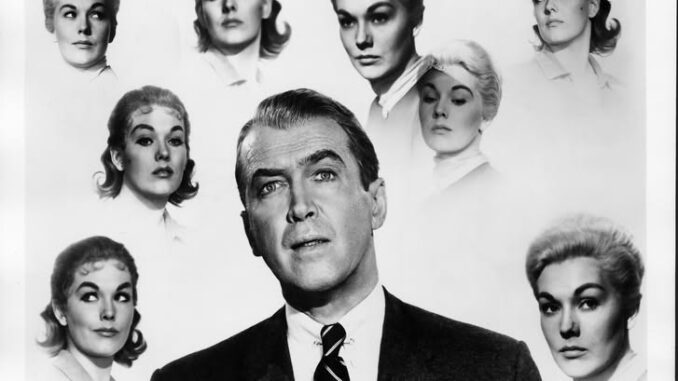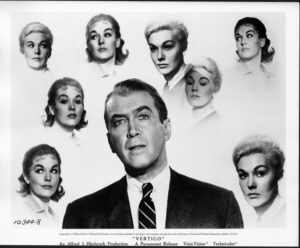
On May 9, 1958, Vertigo, directed by the legendary Alfred Hitchcock and starring James Stewart and Kim Novak, premiered at the Stage Door Theater in San Francisco, California. Though the film was initially met with mixed reviews and underwhelming critical reception, Vertigo has since become one of the most acclaimed films in cinematic history. It is now widely regarded as Hitchcock’s masterpiece and a landmark in the thriller genre. In fact, the movie was ranked number one in the 2012 Sight and Sound poll of the “Top 100 Greatest Films of All Time,” cementing its status as a timeless classic.
The Story Behind Vertigo
Vertigo tells the haunting tale of a retired police detective, John “Scottie” Ferguson (played by James Stewart), who suffers from acrophobia (fear of heights) and vertigo. After a traumatic incident during a police chase, Scottie is forced to retire. However, his past catches up with him when an old acquaintance, Gavin Elster, asks for his help to follow his wife, Madeleine (Kim Novak), who is acting strangely and appears to be obsessed with a long-dead ancestor.

What follows is a psychological thriller full of suspense, obsession, and deception. The film explores themes of identity, love, and the fragility of the human mind. Hitchcock’s masterful direction and Bernard Herrmann’s iconic musical score create an atmosphere that lingers with viewers long after the credits roll.
Initial Reception: A Film Ahead of Its Time
At the time of its release, Vertigo did not receive the acclaim it enjoys today. Critics were divided, and the film did not perform well at the box office. Many audiences found its complex narrative and melancholic tone difficult to embrace, especially compared to Hitchcock’s earlier hits like Psycho (1960) or Rear Window (1954).
However, over the following decades, film scholars, critics, and audiences began to reevaluate Vertigo more favorably. Its exploration of psychological depth and its innovative cinematic techniques were seen as groundbreaking. This reevaluation sparked a resurgence of interest in the film and Hitchcock’s work as a whole.
Cinematic Innovation and Visual Style
One of the reasons Vertigo remains influential is its pioneering use of visual effects to represent psychological states. Hitchcock and his team famously developed the “dolly zoom” (also known as the “Vertigo effect”), a camera technique that creates a disorienting sense of vertigo by simultaneously zooming in while moving the camera backward. This technique effectively conveys Scottie’s fear of heights and has since been widely adopted in filmmaking.
The film’s visual style is equally impressive, with stunning compositions and carefully curated color palettes that underscore the mood of each scene. The recurring use of green hues symbolizes obsession and jealousy, adding another layer to the storytelling. Hitchcock’s attention to detail, combined with the haunting musical score by Bernard Herrmann, immerses viewers in a deeply unsettling yet captivating cinematic experience.
Themes and Interpretations
Vertigo is not just a suspense thriller; it is a film rich with symbolic meaning and psychological complexity. Themes of identity, control, and obsession are woven throughout the narrative. Scottie’s struggle to recreate Madeleine in the image of an idealized woman speaks to human desires for control and the impossibility of truly knowing another person.
The film also touches on the darker aspects of love and obsession, blurring the lines between reality and illusion. This ambiguity has inspired countless interpretations and debates among film enthusiasts and scholars, ensuring Vertigo’s enduring relevance in cinema discussions.
Legacy and Influence
The legacy of Vertigo extends far beyond its initial release. Today, it is studied in film schools worldwide as a prime example of psychological storytelling and innovative direction. The film’s influence can be seen in numerous movies and TV shows that explore similar themes of obsession, identity, and unreliable narration.
In 2012, the British Film Institute’s Sight and Sound magazine conducted a once-a-decade poll of critics and filmmakers to determine the greatest films of all time. Vertigo topped the list, surpassing classics like Citizen Kane and The Godfather, highlighting its elevated status in the film canon.
Why Watch Vertigo Today?
For modern audiences, Vertigo offers a unique blend of classic Hollywood storytelling and avant-garde cinematic techniques. Its rich narrative and psychological depth make it a rewarding viewing experience for both casual movie lovers and serious cinephiles.
Whether you are a fan of Alfred Hitchcock’s suspenseful style or interested in exploring films that shaped the thriller genre, Vertigo remains essential viewing. Its timeless themes of love, obsession, and identity continue to resonate, making it a masterpiece that stands the test of time.
